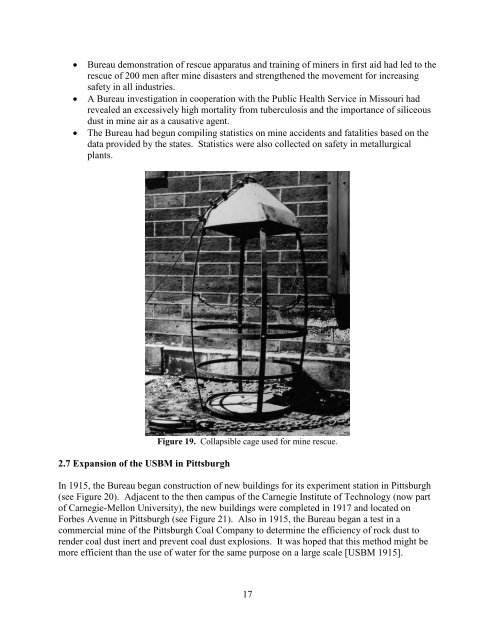One Hundred Years of Federal Mining Safety and Health Research
One Hundred Years of Federal Mining Safety and Health Research
One Hundred Years of Federal Mining Safety and Health Research
- No tags were found...
You also want an ePaper? Increase the reach of your titles
YUMPU automatically turns print PDFs into web optimized ePapers that Google loves.
• Bureau demonstration <strong>of</strong> rescue apparatus <strong>and</strong> training <strong>of</strong> miners in first aid had led to the<br />
rescue <strong>of</strong> 200 men after mine disasters <strong>and</strong> strengthened the movement for increasing<br />
safety in all industries.<br />
• A Bureau investigation in cooperation with the Public <strong>Health</strong> Service in Missouri had<br />
revealed an excessively high mortality from tuberculosis <strong>and</strong> the importance <strong>of</strong> siliceous<br />
dust in mine air as a causative agent.<br />
• The Bureau had begun compiling statistics on mine accidents <strong>and</strong> fatalities based on the<br />
data provided by the states. Statistics were also collected on safety in metallurgical<br />
plants.<br />
2.7 Expansion <strong>of</strong> the USBM in Pittsburgh<br />
Figure 19. Collapsible cage used for mine rescue.<br />
In 1915, the Bureau began construction <strong>of</strong> new buildings for its experiment station in Pittsburgh<br />
(see Figure 20). Adjacent to the then campus <strong>of</strong> the Carnegie Institute <strong>of</strong> Technology (now part<br />
<strong>of</strong> Carnegie-Mellon University), the new buildings were completed in 1917 <strong>and</strong> located on<br />
Forbes Avenue in Pittsburgh (see Figure 21). Also in 1915, the Bureau began a test in a<br />
commercial mine <strong>of</strong> the Pittsburgh Coal Company to determine the efficiency <strong>of</strong> rock dust to<br />
render coal dust inert <strong>and</strong> prevent coal dust explosions. It was hoped that this method might be<br />
more efficient than the use <strong>of</strong> water for the same purpose on a large scale [USBM 1915].<br />
17
















